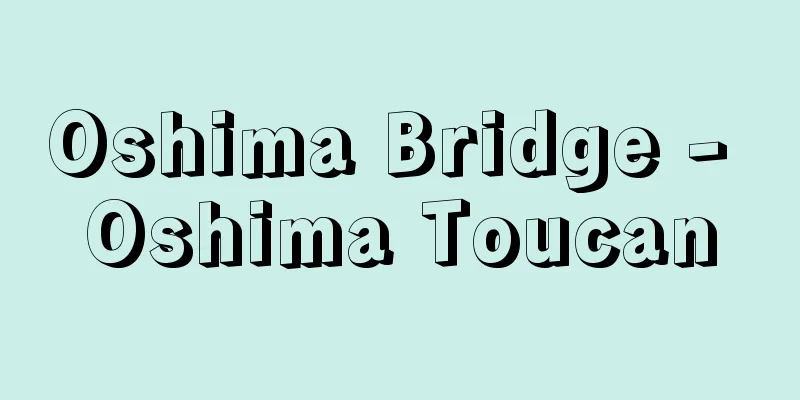Ikebukuro

|
A district located almost in the center of Toshima-ku, Tokyo. It is one of the sub-centers of Tokyo, where JR Yamanote Line, Saikyo Line, Shonan-Shinjuku Line, Tobu Railway Tojo Line, Seibu Railway Ikebukuro Line, Tokyo Metro Marunouchi Line, Yurakucho Line, and Fukutoshin Line converge, and together with Shinjuku and Shibuya, it forms a lively shopping and entertainment district. There used to be many ponds around here, and until the late 1990s, there was a small pond in Moto-Ikebukuro Park, south of the west exit of Ikebukuro Station, that was said to be a remnant of Maruike Pond, a famous spot for fireflies and the moon during the Edo period. This Maruike Pond is the source of the Tsurumaki River, and the surrounding area is a depression that looks like a bag, which is said to be the origin of the place name. From the Edo period to the mid-Meiji period, it was Ikebukuro Village, Toshima County, etc. Located on the Yamate Plateau, the surrounding area was once a large field, but in 1903 (Meiji 36), Ikebukuro Station on the Japanese Railway Shinagawa Line and Toshima Line (currently the JR Saikyo Line and Yamanote Line) was opened, and in 1909, Toshima Normal School was established, and the area began to develop. In 1914 (Taisho 3), the Tojo Line (currently the Tobu Tojo Line) was opened, and the following year, in 1915, the Musashino Line (currently the Seibu Ikebukuro Line) was opened, and in 1918, Rikkyo University was relocated from Tsukiji. However, before World War II, the neighboring station of Otsuka was more prosperous. After the war, as the suburbs were rapidly developed into residential areas, Ikebukuro's superiority led to further development, and especially after the opening of the Teito Rapid Transit Marunouchi Line (currently the Tokyo Metro Marunouchi Line) in 1954 (Showa 29), it developed into a secondary city center. On the east side of the station, there are Seibu, Ikebukuro Parco, large electronics retailers, movie theaters, restaurants, and shops. In 1978, Sunshine City was built on the site of the former Tokyo Detention House (Sugamo Prison), and houses the World Import Mart with its 240m high-rise Sunshine 60. There are also the World Import Mart with its International Aquarium and Planetarium, the Alpa shopping mall, the Cultural Center with its Ancient Orient Museum and Sunshine Theater, and a hotel. On the other hand, the west exit of the station was a slum area of black market merchants after the war, but was reorganized in 1962 and given a new look, with the Tobu Department Store, Tokyo Metropolitan Theatre, hotels, and banks now located there, and the former site of Toshima Shihan College is now Ikebukuro West Exit Park. Jiyugakuen Myonichikan (built in 1921) in Nishi-Ikebukuro is a nationally designated (1997) Important Cultural Property, designed by F. L. Wright, who is known for designing the Imperial Hotel. Moto-Ikebukuro Park, which once had a small pond thought to be a remnant of Maruike Pond, was relocated due to sewerage construction work, and the small pond was filled in. A monument commemorating the "pond associated with the name Ikebukuro" remains at Moto-Ikebukuro Historical Park, which opened to the east in 1998. [Kiyoshi Sawada] [Reference item] | |This cultural facility was established by the Tokyo Metropolitan Government with the aim of promoting arts and culture for Tokyo residents and international exchange. It opened in 1990 (Heisei 2). It has 10 floors above ground and 4 floors below ground, and in addition to a large hall with seating for 1,999 people, there are three medium-sized and small halls. The pipe organ installed at the center of the stage of the large hall, which is used exclusively for concerts, is one of the largest in the world. The building also has conference rooms and exhibition galleries, and is used for various events. Toshima-ku, Tokyo ©Yutaka Sakano "> Tokyo Metropolitan Theatre Built in 1921 (Taisho 10) as a school building for Jiyu Gakuen, founded by husband and wife Yoshikazu and Motoko Hani. Designed by American architect F. L. Wright. After Jiyu Gakuen moved to Higashikurume, Tokyo in 1934 (Showa 9), the building has been used mainly for the business activities of graduates. Although it escaped the Great Kanto Earthquake and war damage, it deteriorated over the years, and conservation and repair work was carried out over a period of two and a half years starting in 1999 (Heisei 11). Nationally designated important cultural property Toshima-ku, Tokyo ©Yutaka Sakano "> Jiyu Gakuen Myonichikan Source: Shogakukan Encyclopedia Nipponica About Encyclopedia Nipponica Information | Legend |
|
東京都豊島区(としまく)のほぼ中央にある一地区。JR山手(やまのて)線・埼京線・湘南新宿ライン、東武鉄道東上線、西武鉄道池袋線、東京地下鉄丸ノ内線・有楽町(ゆうらくちょう)線・副都心線が集まる副都心の一つで、新宿、渋谷(しぶや)とともに、にぎやかな商店街、歓楽街を形成している。かつて、このあたりには多くの池があり、1990年代後半まで、池袋駅西口の南、元池袋公園内には、江戸時代にホタルと月の名所であった丸池の名残(なごり)とされる小池があった。この丸池は弦巻(つるまき)川の水源池で、付近は窪地(くぼち)になっていて地形が袋のようになっていたことが地名の由来という。江戸時代から明治中期まで豊島郡池袋村など。山手台地上にあり、付近一帯は広い畑地であったが、1903年(明治36)日本鉄道品川線・豊島線(現、JR埼京線・山手線)の池袋駅が開設され、1909年豊島師範学校ができてから発展し始めた。1914年(大正3)東上鉄道(現、東武東上線)、翌1915年武蔵野(むさしの)鉄道(現、西武池袋線)が開通し、1918年には築地(つきじ)から立教大学が移転してきた。しかし、第二次世界大戦前は隣駅の大塚のほうが繁栄していた。戦後、郊外の住宅地化が急激に進むにつれ、池袋の優位性が発展を引き起こし、とくに1954年(昭和29)営団地下鉄丸ノ内線(現、東京地下鉄丸ノ内線)が開通してから副都心へと発展した。駅の東側には西武、池袋パルコ、大型家電量販店、映画館、飲食店、商店などが集まる。また旧東京拘置所(巣鴨プリズン)跡地に1978年高層建築のサンシャイン60(240メートル)を有するサンシャインシティが建設され、国際水族館やプラネタリウムがあるワールドインポートマート、専門店街のアルパ、古代オリエント博物館やサンシャイン劇場がある文化会館、ホテルなどの建物がある。一方、駅の西口は戦災後、闇(やみ)屋のバラック街であったが、1962年整理され面目を一新し、東武百貨店、東京芸術劇場のほか、ホテル、銀行などがあり、旧豊島師範跡は池袋西口公園になっている。西池袋の自由学園明日館(じゆうがくえんみょうにちかん)(1921年建築)は国指定(1997)重要文化財で、帝国ホテルの設計で知られるF・L・ライトの手になる。丸池の名残とされる小池があった元池袋公園は下水道工事に伴い移転し、小池も埋められた。1998年(平成10)東隣に開園した元池袋史跡公園に「池袋地名ゆかりの池」の記念碑が残されている。 [沢田 清] [参照項目] | |東京都が都民のための芸術文化の振興と国際交流を目的に開設した文化施設。1990年(平成2)開館。地上10階・地下4階で、客席数1999席の大ホールのほか、三つの中・小ホールがある。コンサート専用の大ホールのステージ中央上部に設置されているパイプ・オルガンは世界最大級。館内には会議室や展示ギャラリーなどもあり、各種イベントに利用される。東京都豊島区©Yutaka Sakano"> 東京芸術劇場 1921年(大正10)、羽仁吉一・もと子夫妻が創立した自由学園の校舎として建築。設計はアメリカの建築家F・L・ライト。34年(昭和9)に自由学園が東京都東久留米市に移転してからは、おもに卒業生の事業活動に利用されてきた。関東大震災や戦災を免れたものの、長い歳月のなかで老朽化が進み、99年(平成11)から2年半をかけて保存修理工事が行われた。国指定重要文化財 東京都豊島区©Yutaka Sakano"> 自由学園明日館 出典 小学館 日本大百科全書(ニッポニカ)日本大百科全書(ニッポニカ)について 情報 | 凡例 |
<<: Ikebe Sanzan - Ikebe Sanzan
Recommend
Ludwig II - Ludwig
The fourth king of Bavaria (reigned 1864-1886). He...
Kun - Kun
It refers to the Japanese words that correspond t...
Charlie
1862‐1934 Swedish astronomer. Professor of astrono...
Benjamin Disraeli, 1st Earl of Beaconsfield
British politician. Born as the eldest son of Jew...
Endoslyta sinensis (English spelling)
…[Hiroshi Inoue]. … *Some of the terminology that...
Sturm und Drang
A German literary movement from the late 1760s to ...
Mitsutoyo Kanjuji
Year of death: October 27, 1612 (November 19, 1612...
Daikyoji Mukashigoyomi - Daikyoji Mukashigoyomi
Joruri Gidayubushi (a type of Japanese recital). ...
Dimples - Dimples
〘Noun〙 (meaning "laughing dimples") 1. T...
Kakuteizuka Tomb
...It is a traditional contest of strength that h...
Guanaco - Guanaco (English spelling)
A member of the Mammalia class, Order Artiodactyl...
Xu Ling (English spelling)
[Live] Tiankan 6 (507) [Death] Shitoku 1 (583) A C...
Northeast Anti-Japanese United Army (English: Northeast Anti-Japanese United Army)
An anti-Japanese guerrilla army organized in North...
Dried fish - Kiriboshi
A type of dried vegetable. Sweet potatoes and eggp...
Eurasian Siskin (Siskin) - Eurasian Siskin (Siskin)
A bird of the family Fringillidae (illustration) i...




![Nakaniida [town] - Nakaniida](/upload/images/67cc63fb4c95f.webp)




